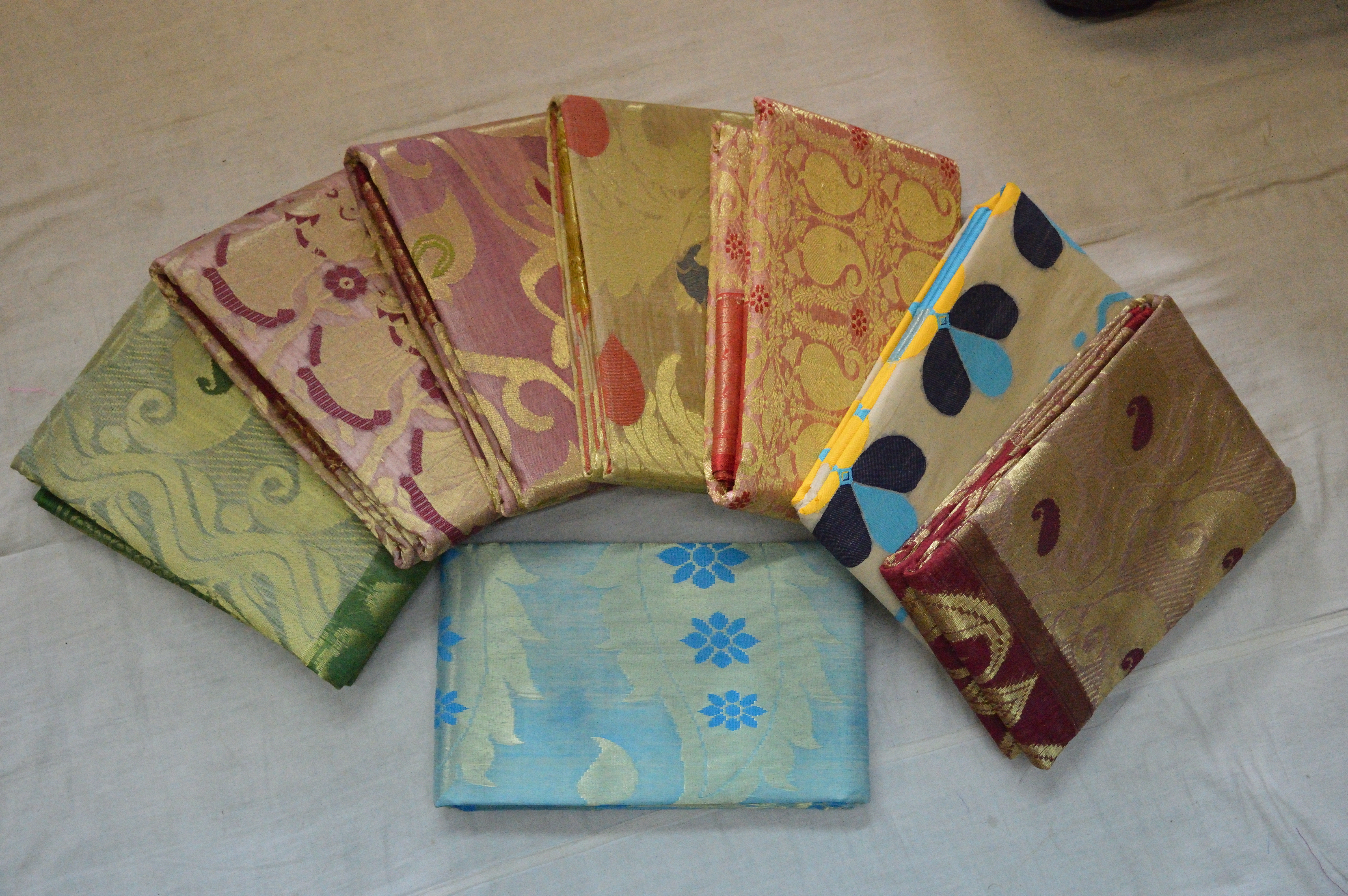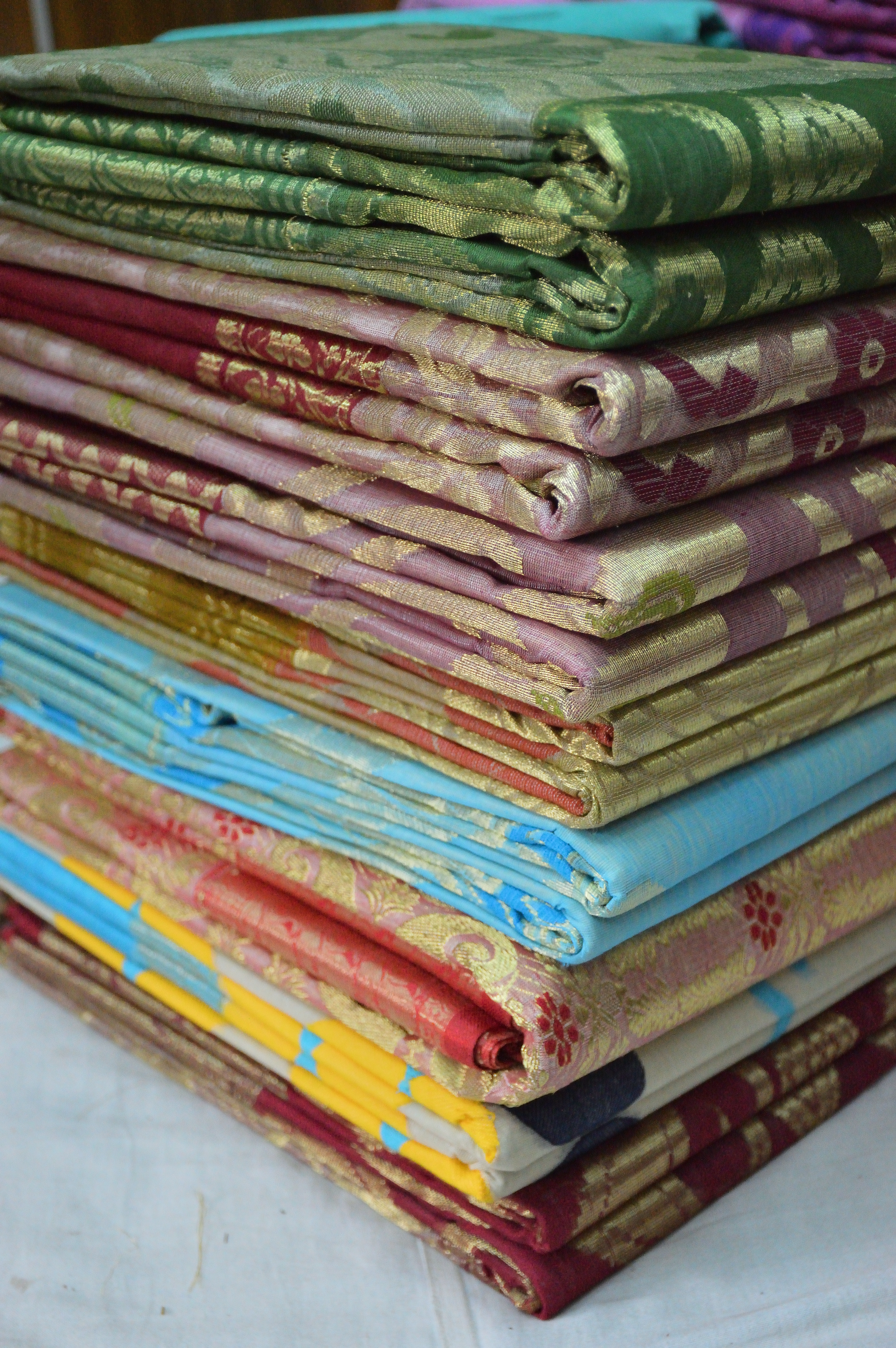Tussah on:
[Wikipedia]
[Google]
[Amazon]
 Tussar silk (alternatively spelled as tussah, tushar, tassar, tussore, tasar, tussur, or tusser, and also known as (Sanskrit) ''kosa'' silk) is produced from larvae of several species of silkworms belonging to the moth genus '' Antheraea'', including '' A. assamensis'', '' A. paphia'', '' A. pernyi'', '' A. roylei'', and '' A. yamamai''. These silkworms live in the wild forests in trees belonging to '' Terminalia'' species and ''
Tussar silk (alternatively spelled as tussah, tushar, tassar, tussore, tasar, tussur, or tusser, and also known as (Sanskrit) ''kosa'' silk) is produced from larvae of several species of silkworms belonging to the moth genus '' Antheraea'', including '' A. assamensis'', '' A. paphia'', '' A. pernyi'', '' A. roylei'', and '' A. yamamai''. These silkworms live in the wild forests in trees belonging to '' Terminalia'' species and ''
 India is the second-largest producer of tussar silk, and the exclusive producer of Indian tussar (also known as tropical tussar), which is largely tended to by
India is the second-largest producer of tussar silk, and the exclusive producer of Indian tussar (also known as tropical tussar), which is largely tended to by
Shorea robusta
''Shorea robusta'', the sal tree, sāla, shala, sakhua, or sarai, is a species of tree in the family Dipterocarpaceae. The tree is native to India, Bangladesh, Nepal, Tibet and across the Himalayan regions .
Evolution
Fossil evidence from l ...
'', as well as other food plants such as jamun and oak found in South Asia, eating the leaves of the trees on which they live. Tussar silk is valued for its rich texture and natural, deep-gold colour, and varieties are produced in many countries, including China,Su Jing, Lun Luo, ''Landlord and Labor in Late Imperial China: Case Studies from Shandong'', Harvard University Asia Center, 1978 India
India, officially the Republic of India (Hindi: ), is a country in South Asia. It is the List of countries and dependencies by area, seventh-largest country by area, the List of countries and dependencies by population, second-most populous ...
, Japan
Japan ( ja, 日本, or , and formally , ''Nihonkoku'') is an island country in East Asia. It is situated in the northwest Pacific Ocean, and is bordered on the west by the Sea of Japan, while extending from the Sea of Okhotsk in the n ...
, and Sri Lanka
Sri Lanka (, ; si, ශ්රී ලංකා, Śrī Laṅkā, translit-std=ISO (); ta, இலங்கை, Ilaṅkai, translit-std=ISO ()), formerly known as Ceylon and officially the Democratic Socialist Republic of Sri Lanka, is an ...
.
Process
To kill the silkworms, the cocoons are dried in the sun. A variation of the process exists in which the silkworms are allowed to leave before the cocoons are soaked in boiling water to soften the silk, and then the fibers are reeled. Single-shelled, oval-shaped cocoons are collected and then boiled to extract the silk yarn. Boiling is a very important part in the manufacturing of silk, as it softens the cocoon and makes the extraction of silk easier. In conventionalsericulture
Sericulture, or silk farming, is the cultivation of silkworms to produce silk. Although there are several commercial species of silkworms, '' Bombyx mori'' (the caterpillar of the domestic silkmoth) is the most widely used and intensively stud ...
, the cocoons are boiled with the larvae still inside, but if the cocoons are boiled after the larvae have left them, the silk made is then called "nonviolent silk" or "Ahimsa silk
Ahimsa silk (''ahiṃsā'': Sanskrit for 'nonviolence') is a method of nonviolent silk breeding and harvesting. Wild silk moths are bred, rather than the domestic variety. It allows the completion of the metamorphosis of the silkworm to its moth s ...
". In China, the silks are given different names when silkworms are reared on different plants, as the diet of the silkworms has an effect on the quality of the silk. For example, silk from larvae on the wild mulberry
''Morus'', a genus of flowering plants in the family Moraceae, consists of diverse species of deciduous trees commonly known as mulberries, growing wild and under cultivation in many temperate world regions. Generally, the genus has 64 ident ...
is called ''zhe'', while those on the oak ''Quercus dentata
''Quercus dentata'', also called Japanese emperor oak or daimyo oak ( ja, 柏, ''kashiwa''; ; ko, 떡갈나무, ''tteokgalnamu'') is a species of oak native to East Asia ( Japan, Korea and China). The name of the tree is often translated as ...
'' produce ''hu''.
Tussar silk is considered more textured than cultivated ''Bombyx
''Bombyx'' is the genus of true silk moths or mulberry silk moths of the family Bombycidae, also known as silkworms, which are the larvae or caterpillars of silk moths. The genus was erected as a subgenus by Carl Linnaeus in his 10th edition ...
'' or "mulberry" silk, but it has shorter fibres, which makes it less durable. It has a dull, gold sheen. As most of the cocoons are collected from the forest, it is considered by many as a forest product.
Production in India
tribals
The term tribe is used in many different contexts to refer to a category of human social group. The predominant worldwide usage of the term in English is in the discipline of anthropology. This definition is contested, in part due to conflic ...
. Much of it is produced in Bhagalpur
Bhagalpur is a city in the Indian state of Bihar, situated on the southern banks of the river Ganges. It is the 2nd largest city of Bihar by population and also the headquarters of Bhagalpur district and Bhagalpur division. Known as the Si ...
(where it is called Bhagalpur silk), Bihar
Bihar (; ) is a state in eastern India. It is the 2nd largest state by population in 2019, 12th largest by area of , and 14th largest by GDP in 2021. Bihar borders Uttar Pradesh to its west, Nepal to the north, the northern part of West ...
, and Malda district
Malda district, also spelt Maldah or Maldaha (, , often ), is a district in West Bengal, India. It lies 347 km (215 miles) north of Kolkata, the capital of West Bengal. Mango, jute and silk are the most notable products of this district. ...
of West Bengal
West Bengal (, Bengali: ''Poshchim Bongo'', , abbr. WB) is a state in the eastern portion of India. It is situated along the Bay of Bengal, along with a population of over 91 million inhabitants within an area of . West Bengal is the fou ...
. Tussar silk is also used for Odisha
Odisha (English: , ), formerly Orissa ( the official name until 2011), is an Indian state located in Eastern India. It is the 8th largest state by area, and the 11th largest by population. The state has the third largest population of ...
's '' pattachitra'' and West Bengal's ''kantha
Kantha also spelled kanta, and qanta, is a type of embroidery craft in the Bangladesh and eastern regions of India, particularly in the Indian states of West Bengal, Tripura and Odisha. In Odisha, old saris are stacked on each other and hand-sti ...
'' stitches. Chhattisgarh
Chhattisgarh (, ) is a landlocked state in Central India. It is the ninth largest state by area, and with a population of roughly 30 million, the seventeenth most populous. It borders seven states – Uttar Pradesh to the north, Madhya Prad ...
and Madhya Pradesh
Madhya Pradesh (, ; meaning 'central province') is a state in central India. Its capital is Bhopal, and the largest city is Indore, with Jabalpur, Ujjain, Gwalior, Sagar, and Rewa being the other major cities. Madhya Pradesh is the second ...
also produce tussar silk. In recent years, the state of Jharkhand
Jharkhand (; ; ) is a state in eastern India. The state shares its border with the states of West Bengal to the east, Chhattisgarh to the west, Uttar Pradesh to the northwest, Bihar to the north and Odisha to the south. It has an area of . I ...
has emerged as the biggest producer of tussar silk.
Bhagalpur silk
The tussar silk-weaving industry inBhagalpur
Bhagalpur is a city in the Indian state of Bihar, situated on the southern banks of the river Ganges. It is the 2nd largest city of Bihar by population and also the headquarters of Bhagalpur district and Bhagalpur division. Known as the Si ...
, more than a century old, has about 30,000 handloom weavers working on some 25,000 handlooms. The total value of annual trade is around Rs 100 crore
A crore (; abbreviated cr) denotes ten million (10,000,000 or 107 in scientific notation) and is equal to 100 lakh in the Indian numbering system. It is written as 1,00,00,000 with the local 2,2,3 style of digit group separators (one lakh is eq ...
s, about half of which comes from exports.
Uses
The ''saree'' is the most important tussar silk product although it is also used as the base material for handicrafts, furnishing fabrics, and stitched apparel. With the introduction of chemical dyes, the range of available colors has increased significantly. Some fashion designers use tussar silk in their creations. The precisely finished and designer garments produced from tussar silk are known globally and are exported worldwide. Tussar silk is a popular additive tosoap
Soap is a salt of a fatty acid used in a variety of cleansing and lubricating products. In a domestic setting, soaps are surfactants usually used for washing, bathing, and other types of housekeeping. In industrial settings, soaps are us ...
. The short silk fibers are typically dissolved in lye water, which is then added to oils to make soap. Soap made with tussar silk has a "slippery" quality and is considered more luxurious-feeling than soap made without. Tussar silk roving can be bought at soapmaking supply stores.
References
{{Saree Silk Silk production Silk in India Indian clothing Woven fabrics Antheraea